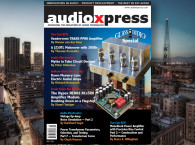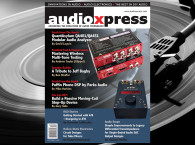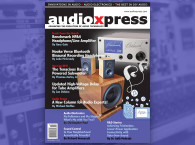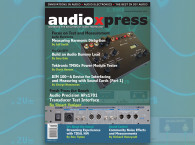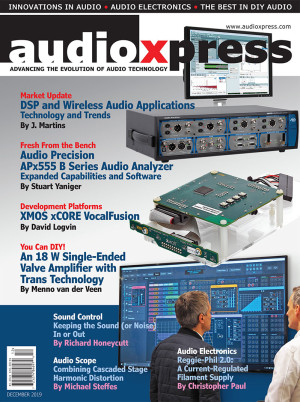 Now available, our last edition of audioXpress for 2019 dives into the latest wireless audio and DSP platforms and solutions. In a Market Update on DSP and Wireless Audio, audioXpress closely examines new solutions and technology trends in these two critical domains for audio product designs. As this edition's editorial states, "So many good-sounding products we use today have a bit - or a lot! - of DSP magic doing its part, even very high-end products. But of course, the benefit for the vast majority of people is in affordable products manufactured by the millions."
Now available, our last edition of audioXpress for 2019 dives into the latest wireless audio and DSP platforms and solutions. In a Market Update on DSP and Wireless Audio, audioXpress closely examines new solutions and technology trends in these two critical domains for audio product designs. As this edition's editorial states, "So many good-sounding products we use today have a bit - or a lot! - of DSP magic doing its part, even very high-end products. But of course, the benefit for the vast majority of people is in affordable products manufactured by the millions."
The Market Update discusses the state-of-the-art in processing hardware for digital signal applications in audio, the emergence of "smart platforms" that explore DSP to tackle some key challenges such as acoustic compensation, noise reduction, and speech processing. The article also compares the options and implications between embedded platforms, FPGA, dedicated processors, and SoCs. In a dedicated section, the Market Update discusses Wireless Audio Technology and Trends, including the Wi-Fi and WiSA market landscape, and a detailed look at the latest Bluetooth codecs, including the new Qualcomm aptX Adaptive Audio Codec.
Stuart Yaniger offers his review of the latest Audio Precision APx555 B Series audio analyzer, and the corresponding new updated V5 software for the APx series. The APx B series now features a new High Performance Sine Generator and a High Performance Sine Analyzer, which Audio Precision claims reduces THD+N to better than -120 dB, with a 1 MHz bandwidth and Fast Fourier Transforms (FFTs) of up to 1.2 million points. This is a significant improvement over its previous series of instruments, which were certainly not slouches in the distortion and noise department. One might reasonably ask about the practicality of this improvement, but audioXpress had been dealing with multiple systems under review where measurements were limited by the analyzer, not the DUT. When audioXpress was given the chance to have a B Series for a few weeks, Yaniger felt like "the coolest kid on the block." His article also explores how Audio Precision addressed the need to create new measurement routines, respond to the challenges of new classes of connected devices, and make the entire solution far more intuitive and simple to use.
Touching on the topic of voice capture and speech processing, David Logvin shares his experience with one of the most sophisticated development platforms currently available, the xCORE VocalFusion Speaker Linear Kit by XMOS. This is a Development Platform for those who want to integrate voice user interfaces into consumer electronics typically found at the edge of the room, such as smart home control panels and washing machines. The article details how these solutions fast-track development of smart speaker and voice-assisted communication products, and how it can help solve the many typical acoustic problems that exist in the real world.
This month, Richard Honeycutt's Sound Control article discuses sound isolation and ways in which noise can be controlled, taking into account the differences between outdoor and indoor conditions. Next, in our new column Audio Scope, while characterizing a new two-stage high-speed amplifier, Michael Steffes re-confirms a theory that cascaded amplifier + ADC harmonic distortion combine as voltage swings.
Another great Audio Electronics article, inspired by previous articles published by audioXpress, in "Reggie-Phil 2.0: A Current-Regulated Filament Supply," Christopher Paul explores alternative approaches to the design of a linear current regulator for audio tube amplifiers, including employing feedback to sense load and other design strategies.
And for our readers eager to get some hands-on inspiration, this December 2019 edition of audioXpress includes another unique and inspiring project of an 18 W single-ended valve amplifier using Trans technology. Regardless of being familiar or not with Transconductance, many of readers will associate the topic with Menno van der Veen, his book, and several audioXpress articles on the topic. This DIY article shows an easy-to-build amplifier using Trans technology with pentodes, current sources, and toroidal transformers. The amplifier was originally created by Menno van der Veen to support his TubeSociety students in the Netherlands.
 And closing this month's edition, again with a tube-inspired topic, in his regular column "Hollow-State Electronics," Richard Honeycutt investigates whether or not swapping out comparable tubes makes any audible difference in a guitar amplifier’s sound.
And closing this month's edition, again with a tube-inspired topic, in his regular column "Hollow-State Electronics," Richard Honeycutt investigates whether or not swapping out comparable tubes makes any audible difference in a guitar amplifier’s sound.
All that, and much more, in another great edition of audioXpress, now available online, and on its way to those who subscribe to the print edition. To read this edition now, you will need to subscribe to audioXpress. Print and/or Digital subscriptions are available. Subscribe to the digital online version and get immediate access at: www.audioxpress.com/page/audioXpress-Subscription-Services.html
If you wish to buy a single printed issue or the complete audioXpress archive on USB, from 2000 to 2019 (yes, including the latest issue), just visit our online shop at www.cc-webshop.com.
Don't miss out, get your copy of audioXpress right now at www.gotomyxpress.com

- on Magazine News
- News
Cutting-Edge Audio Technologies and Trends in audioXpress December 2019
November 11 2019, 03:10
audioXpress December 2019 dives into the latest wireless audio and DSP platforms and solutions in a dedicated Market Update, followed by a review of the latest Audio Precision APx555 B Series audio analyzer. David Logvin shares his experience with the xCORE VocalFusion development platform by XMOS, while Michael Steffes re-confirms a theory that cascaded amplifier + ADC harmonic distortion combine as voltage swings. Christopher Paul explores alternative approaches to the design of a linear current regulator for audio tube amplifiers, Menno van der Veen details an 18 W single-ended valve amplifier using Trans technology, and Richard Honeycutt investigates whether or not swapping out comparable tubes makes any audible difference in a guitar amplifier’s sound. Download your own copy now!


